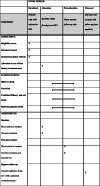Effects of Bilberry and Oat intake on lipids, inflammation and exercise capacity after Acute Myocardial Infarction (BIOAMI): study protocol for a randomized, double-blind, placebo-controlled trial
- PMID: 33971938
- PMCID: PMC8112057
- DOI: 10.1186/s13063-021-05287-5
Effects of Bilberry and Oat intake on lipids, inflammation and exercise capacity after Acute Myocardial Infarction (BIOAMI): study protocol for a randomized, double-blind, placebo-controlled trial
Abstract
Background: Bilberries from Sweden, rich in polyphenols, have shown cholesterol-lowering effects in small studies, and the cholesterol-lowering properties of oats, with abundant beta-glucans and potentially bioactive phytochemicals, are well established. Both may provide cardiometabolic benefits following acute myocardial infarction (AMI), but large studies of adequate statistical power and appropriate duration are needed to confirm clinically relevant treatment effects. No previous study has evaluated the potential additive or synergistic effects of bilberry combined with oats on cardiometabolic risk factors. Our primary objective is to assess cardioprotective effects of diet supplementation with dried bilberry or with bioprocessed oat bran, with a secondary explorative objective of assessing their combination, compared with a neutral isocaloric reference supplement, initiated within 5 days following percutaneous coronary intervention (PCI) for AMI.
Methods: The effects of Bilberry and Oat intake on lipids, inflammation and exercise capacity after Acute Myocardial Infarction (BIOAMI) trial is a double-blind, randomized, placebo-controlled clinical trial. A total of 900 patients will be randomized post-PCI to one of four dietary intervention arms. After randomization, subjects will receive beverages with bilberry powder (active), beverages with high-fiber bioprocessed oat bran (active), beverages with bilberry and oats combined (active), or reference beverages containing no active bilberry or active oats, for consumption twice daily during a 3-month intervention. The primary endpoint is the difference in LDL cholesterol change between the intervention groups after 3 months. The major secondary endpoint is exercise capacity at 3 months. Other secondary endpoints include plasma concentrations of biochemical markers of inflammation, metabolomics, and gut microbiota composition after 3 months.
Discussion: Controlling hyperlipidemia and inflammation is critical to preventing new cardiovascular events, but novel pharmacological treatments for these conditions are expensive and associated with negative side effects. If bilberry and/or oat, in addition to standard medical therapy, can lower LDL cholesterol and inflammation more than standard therapy alone, this could be a cost-effective and safe dietary strategy for secondary prevention after AMI.
Trial registration: ClinicalTrials.gov NCT03620266 . Registered on August 8, 2018.
Keywords: Anthocyanin; Anthocyanin-derived phenolic acid metabolites; Bilberry; Cholesterol; Diet therapy; Exercise test; Inflammation; Myocardial infarction.
Conflict of interest statement
KA and AR are, apart from their academic activities, also Senior Scientist and CSO, respectively, at Glucanova AB. AR, KA, and LHL are involved in the study product conceptualization, development, and production but not in data collection or data analysis.
Figures
Similar articles
-
Freeze-dried bilberry (Vaccinium myrtillus) dietary supplement improves walking distance and lipids after myocardial infarction: an open-label randomized clinical trial.Nutr Res. 2019 Feb;62:13-22. doi: 10.1016/j.nutres.2018.11.008. Epub 2018 Nov 17. Nutr Res. 2019. PMID: 30803503 Clinical Trial.
-
Probiotic fruit beverages with different polyphenol profiles attenuated early insulin response.Nutr J. 2018 Feb 27;17(1):34. doi: 10.1186/s12937-018-0335-0. Nutr J. 2018. PMID: 29486772 Free PMC article. Clinical Trial.
-
Polyphenol-rich bilberry ameliorates total cholesterol and LDL-cholesterol when implemented in the diet of Zucker diabetic fatty rats.Rev Diabet Stud. 2013 Winter;10(4):270-82. doi: 10.1900/RDS.2013.10.270. Epub 2014 Feb 10. Rev Diabet Stud. 2013. PMID: 24841880 Free PMC article.
-
Effect of Barley and Oat Consumption on Immune System, Inflammation and Gut Microbiota: A Systematic Review of Randomized Controlled Trials.Curr Nutr Rep. 2024 Sep;13(3):582-597. doi: 10.1007/s13668-024-00543-x. Epub 2024 May 24. Curr Nutr Rep. 2024. PMID: 38789888 Free PMC article.
-
Narrative Review on the Effects of Oat and Sprouted Oat Components on Blood Pressure.Nutrients. 2022 Nov 11;14(22):4772. doi: 10.3390/nu14224772. Nutrients. 2022. PMID: 36432463 Free PMC article. Review.
Cited by
-
A Systematic Review on Important Risk Factors and Possible Involved Mechanisms of Medicinal Plants on Nonalcoholic Fatty Liver Disease.Adv Biomed Res. 2025 Feb 28;14:20. doi: 10.4103/abr.abr_94_23. eCollection 2025. Adv Biomed Res. 2025. PMID: 40213587 Free PMC article. Review.
-
Effects of Oat Bran Addition on the Growth Performance and Intestinal Health of Nile Tilapia (Oreochromis niloticus) Exposed to Copper Ions.Aquac Nutr. 2023 Jun 20;2023:5329546. doi: 10.1155/2023/5329546. eCollection 2023. Aquac Nutr. 2023. PMID: 37384036 Free PMC article.
-
Oats Lower Age-Related Systemic Chronic Inflammation (iAge) in Adults at Risk for Cardiovascular Disease.Nutrients. 2022 Oct 25;14(21):4471. doi: 10.3390/nu14214471. Nutrients. 2022. PMID: 36364734 Free PMC article. Clinical Trial.
-
Multiple Antioxidative and Bioactive Molecules of Oats (Avena sativa L.) in Human Health.Antioxidants (Basel). 2021 Sep 13;10(9):1454. doi: 10.3390/antiox10091454. Antioxidants (Basel). 2021. PMID: 34573086 Free PMC article. Review.
References
Publication types
MeSH terms
Substances
Associated data
Grants and funding
LinkOut - more resources
Full Text Sources
Other Literature Sources
Medical
Miscellaneous



